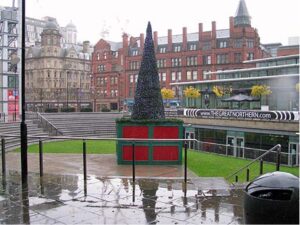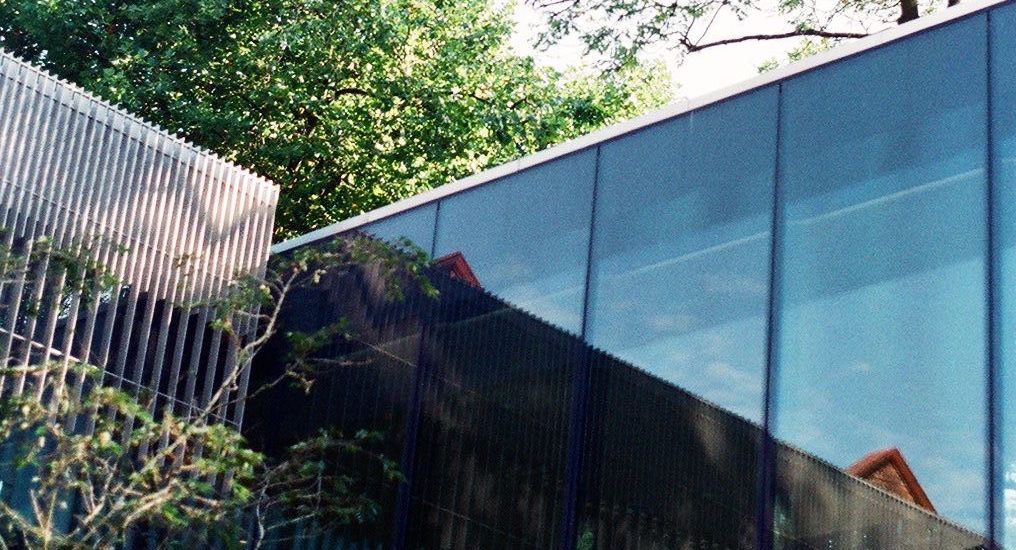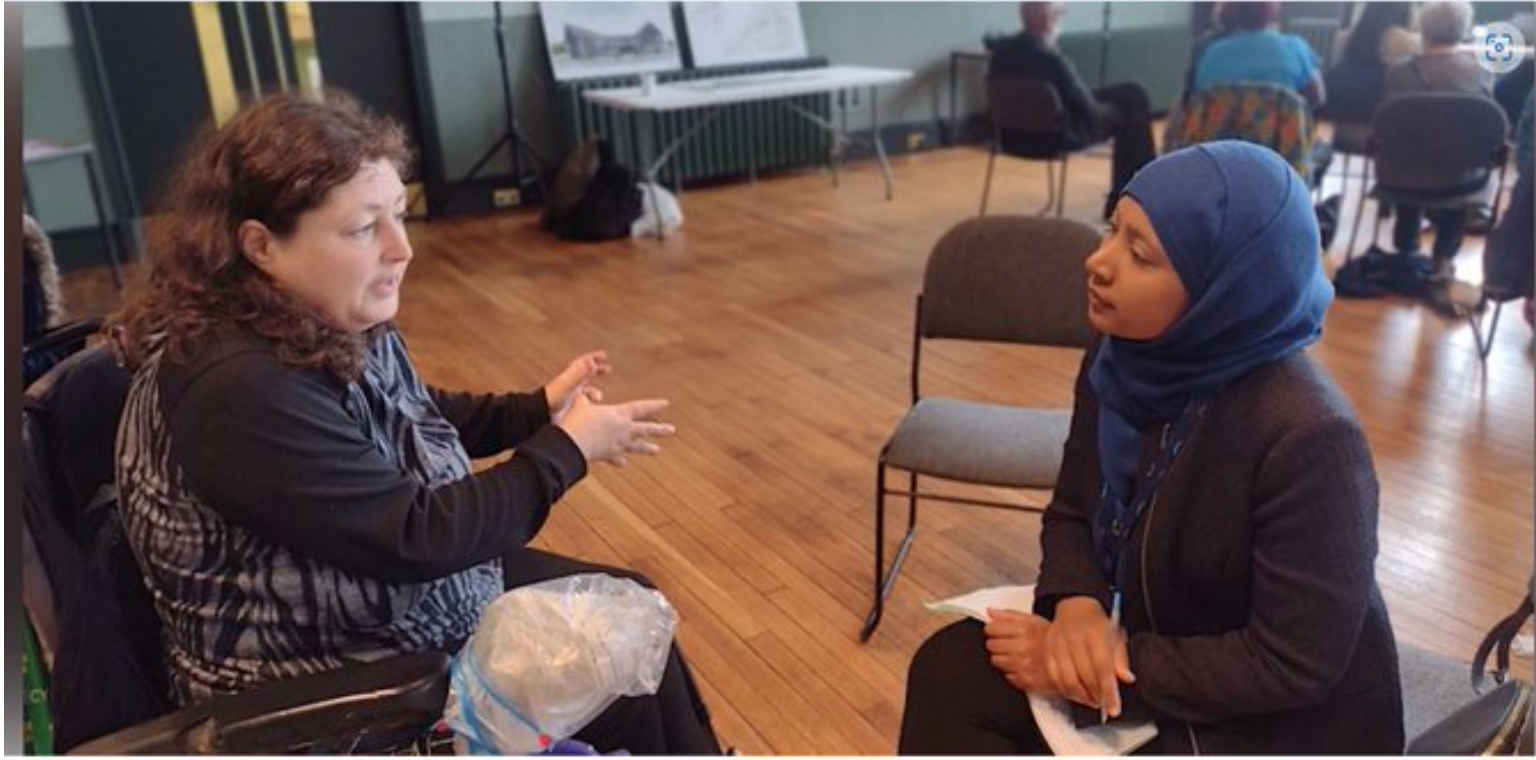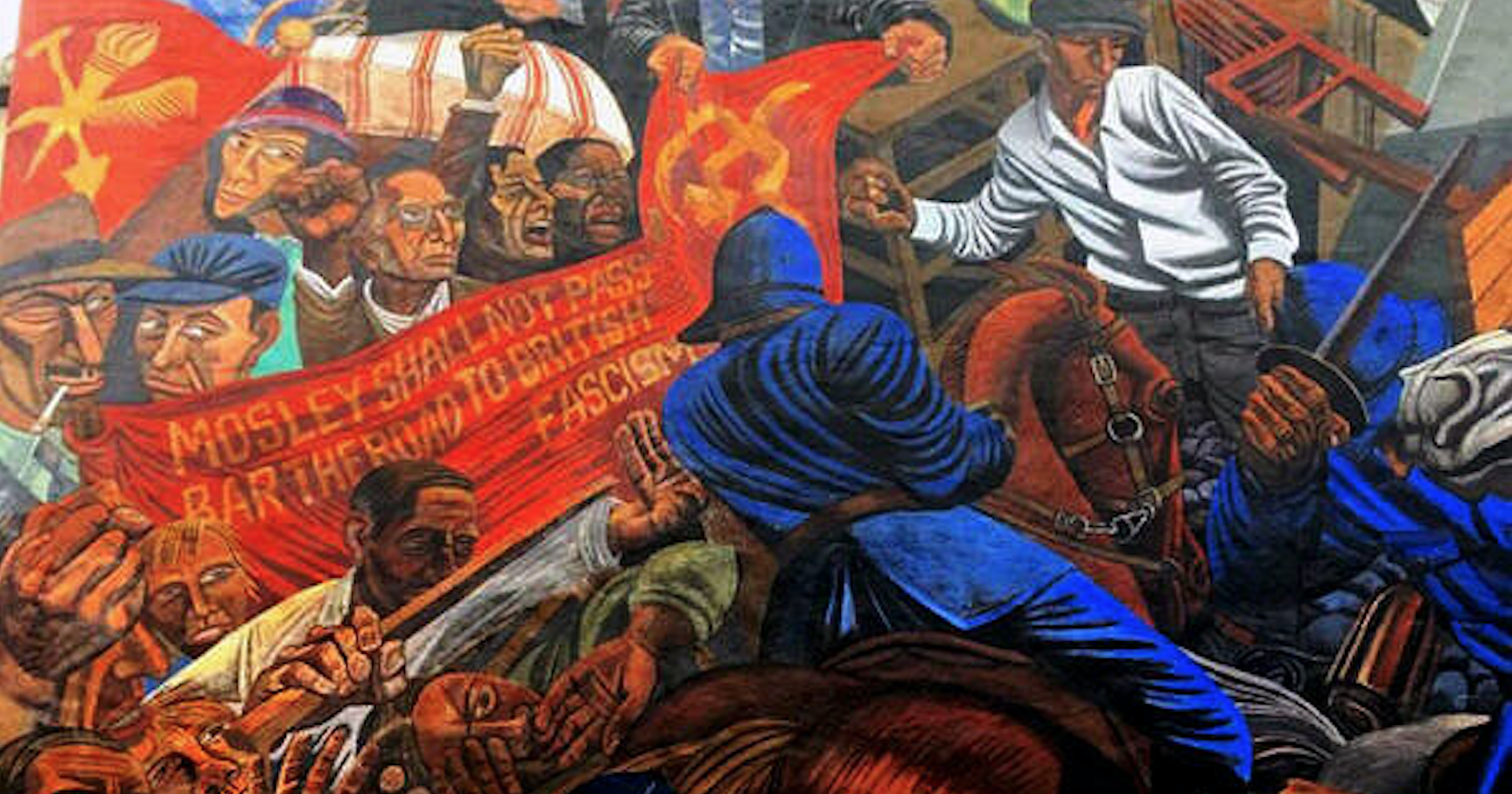By Caitlin Colquhoun (@ckcolq)
Public Space Protection Orders (PSPO) are being increasingly employed across the country. The centre of Manchester has not been spared in their rollout, with the latest attempt to introduce a PSPO in Manchester City Centre. The effects of PSPOs are far-reaching. They give the police broad powers to limit the use of space by a certain group of people and force segregation based on people’s consumption powers. The most recent PSPO submission in Manchester targets the homeless and rough-sleepers who can be fined £100 on the spot for even resting in a doorway.
This article intends to explore the recent cross-continental developments of this increased focus on security and crime prevention and to assess what effects it has had and will continue to have on the social fabric of urban areas. To understand these developments further this article looks at Manchester, U.K, as a case study example and looks at specific policies and urban developments that illustrate this increased focus on crime prevention and security. This increased focus on security and crime prevention became a central feature of government policy in a bid to restructure a previously industrial economy to a tertiary sector led economy. What makes Manchester, with its industrial history, a pertinent example are the changes that have taken place in the city. The changes have not only disrupted the urban fabric of the city but, its rich social makeup. When looking at current and past developments in more detail, I will focus on the prevailing trend of marketisation and the resulting privatisation of local government and, public space.
Historically, there has always been a connection between the spatial organisation of cities and their need to be effective forms of defence from potential outside threats. One need not look further than the Roman walls that surround Barcelona’s old town, or the large forts in Northern India to see a physical manifestation of this spatial relationship. Although one might not think such a strong relationship manifests itself in the contemporary city, this spatial relationship has adapted and transformed to create more subtle forms of ‘defence’ from a more vaguely defined group of ‘outsiders’. It has manifested itself as an increased focus on security and crime prevention to ensure the security of a certain sector of society from other marginalised sectors of society, resulting often in what we now colloquially call gentrification. This phenomenon has been global, its effects and changes in Manchester from the 80s are more often than not transposable to most other metropolises. The changes have not only disrupted the urban fabric of the city but, its rich social makeup.
Deindustrialisation and decline of the inner city
In the past 3 decades, the West has undergone a large restructuring of its economies following the recession in the 1970s. This restructuring saw economies move from being centred around manufacturing to being centred on the financial sector, relying heavily on debt circulation. The growth of the financial sector and accompanying de-industrialisation widened the income gap and created mass unemployment and resulted in an over-stretched social service sector increasingly under pressure to bridge this employment gap. This employment and income divide created a mass exodus of the middle-class from urban cores from the 1970s, leaving ‘enclaves’ or ‘pockets’ of poverty and leaving large swathes of inner cities abandoned.
What remained between such pockets was an increasingly under-funded and under-maintained public realm (consisting of parks and alley ways for example), the only ‘space’ left for those who had been pushed out to the peripheries of society and out of housing. This under-maintained public realm led to an increasing scepticism of the safety of the remaining middle class in city centre, ultimately proliferating a fear of crime in such spaces. This can be seen across America, for example in San Diego where this declining public realm ultimately led to privatisation of large portions of public space.
The social consequences of this increasing fear of crime and privatisation of the public realm is cyclical. From a young age, society teaches us that the public realm is bad, inefficient, and the private realm is good and efficient. At the same time, people were witnessing a declining urban realm, the site of fears about safety and crime. The term ‘socio-agoraphobia’ has been used to describe the fear of public space that has happened as a result. Although this is a rather extreme extrapolation of the social consequences of an increasing focus on crime prevention and security enabled by privatisation, this affect helps to explain why privatisation and redevelopment of public space went largely unprotested in England and beyond: it was perceived to be making the city ‘safe’ for the middle class.
Manchester’s entrepreneurial turn: urban renaissance, policing and surveillance
Urban decay of city centres caused by recession and de-industrialisation in Manchester was in full-force by the 1980s. At the same time, cities were experiencing increasing globalisation and growing competition for foreign and private investment fuelled by the de-regulation of the Stock Market in 1986. Thatcher used this as an opportunity to capitalise on this privatisation — setting up state initiatives, namely Urban Development Corporations (UDCs) across the country. These UDCs aimed to redirect investment from the private sector towards redevelopment. During this period, Manchester saw the introduction of the Central Manchester Development Corporation (1988-96), a public-private partnership that sought to redevelop and create a ‘new, vibrant urban realm’ (language that continues to be used in development advertisements across the country) in the Castlefield area, just outside Manchester City Centre. Setting the trend of public-private partnerships in Manchester for years to come and in effect normalising what is now happening in the city at a much larger scale.
The IRA bombing of central Manchester in 1996 set the perfect stage for ‘urban renaissance’ efforts under New Labour. Their affinity with Manchester saw further public-private policies being implemented in the city. Cityco, a private firm which mimicked American style Business Improvement Districts (BIDs) was put in place in central Manchester in 2000. It became the first of its kind in the country and predated British legislation regarding BIDs. This gave Cityco powers to collect levies from shop renters (as collecting levies from owners as American BIDs do would have required a change in British legislation) in exchange for the creation and maintenance of a ‘Clean and Safe’ retail environment, a clear starting point of the privatisation of the urban realm in both a physical sense and a societal, policing sense.
Clean and Safe sounds ideal to any citizen. But what did the pursuit of this agenda by BIDs mean in practice? It gave private firms the power to decide what and who interfere with this agenda and how to police these areas (using private security) in the name of security and crime prevention. The city centre for Cityco is an investment, and therefore means this part of the urban realm is treated as a financial asset as are other BIDs across the country. The space has to be ‘made safe’, and security and maintenance of these ‘assets’ of public space became central to their running. CCTV and private security guards have been increasingly employed to maintain ‘security’ and reduce crime in these areas of Manchester and have become the norm.
BIDs as an urban policy fed into the Urban Renaissance agenda (1999) under New Labour. The Urban Renaissance agenda adopted a ‘zero-tolerance’ policy (inscribed in legislation) towards crime and anti-social behaviour, an import from New York. Furthermore, crime reduction was made part of urban planning policy through the Urban Policy White Paper (2002) and national policy that put crime prevention at the forefront of planning policy. Therefore while private firms with financial interests in the urban realm increasingly focused on crime prevention and security to encourage consumption, so did the government, in order to facilitate the urban renaissance movement. Leading to the systematic use of hard policing tactics and widespread use of CCTV (even though it’s effectiveness has been disputed).
This urban renaissance agenda has therefore been criticised by academics, for example as a form of ‘urban revanchism’. Urban revanchism is the control of social dynamics through physical and technological means. The line between renaissance and revanchism is one that is increasingly blurred as zero-tolerance policies towards anti-social behaviour employed under the urban renaissance agenda have often led to vilification of minorities through stereotyping, policing and mass surveillance. For example, for the New East Manchester redevelopment projects to go through, a clearing out of ‘unwanted individuals’ was the method that would be employed. Additionally, East Manchester has seen tough policing, often intrusive, in a bid for zero-tolerance of anti-social behaviour.
Undoubtedly, surveillance or policing (may that be private security or public police) have strong effects on the psyche of the population and the ways in which we interact. Forcing mechanical separation of people through policing creates a divide between different parts of society instils a fear of the ‘other’, making society less tolerant of difference. Only those able to consume within the city centre business districts are permitted, otherwise populations come under pressure from the surveillance and policing apparatus of the BIDs. Not only are homeless individuals being pushed out of the urban realm but young people who use such spaces are increasingly being barred and marginalised.
Privatisation of Public Space
This trend towards increased privatisation as the tool used for urban renaissance agendas has led to an inevitable commodification of ‘public space’ — sometimes referred to as ‘cappuccino culture’ — and has been gaining traction in the UK since the early 2000s. Here, ‘public’ space exists for the consuming public and their ‘safety’ is ensured by excluding the non-consuming public through the codification of these spaces; may that be through the presence of private security, CCTV or the design of a space and in most cases, all the above. This increased privatisation is not only of the management of public space but is now also regarding the ownership of seemingly public spaces. This has given rise to pseudo-public spaces (Pops) of which Manchester is no alien to. The Guardian newspaper is continuing to map Pops across the country but, has been met with silence from most of the city councils they contacted including Manchester City Council.
Here in Manchester, there are many examples of Pops. Spinningfields, owned by Allied London, a private firm, has been heralded as a flagship public space in Manchester, The Great Northern Square, a previous industrial site, another Pop, owned by Peterson Group, a property company based in Hong Kong are only two and the list goes on. These are seemingly public spaces however, the companies that own them reserve the right to entry, essentially allowing such spaces to be run, not under the rule of law but, on their own terms. Furthermore, what makes these spaces evermore concerning is that they increasingly blur our understanding of public space. Although the definition of public space itself has never been clear, right of access is a theme that commonly appears. This right of access is under threat given the transfer of decisions regarding right to entry. This affects the public’s right to protest which is the true litmus test for determining whether a space is truly public.

The production of Pops has seen also a trend where they are being produced like pre-fabricated space, increasingly designed with insular designs, turned away from streets and visibly reducing access. They are driven by a narrative or perception around who should and shouldn’t be in these spaces of consumption — in effect reducing the richness of social diversity in cities to a sterile, controlled environment through surveillance and iconography. This codifying of space means that any individual or group that is deemed to disturb this narrative and impede consumption, is removed and barred. Displacing further social problems and inevitably creating a ‘zero-sum game’ where ostracised groups such as the homeless, groups of youths into the periphery, in which they will continue to be vilified. One need not think further than benches retrofitted with metal protrusions to stop skateboarders skating.
The parts of the urban realm that remain under public management and ownership are also being increasingly controlled using private-management techniques on the assumption that they are the ‘solution’. This has been done using Public Space Protection Orders (PSPOs) introduced in 2014. They are a geographical adaptation of ASBOs which were introduced under the Crime and Anti-Social Behaviour act. They allow local councils to create orders that criminalise certain behaviours within a defined geographical area. The local council of Trafford, within Greater Manchester has criminalised the congregation of ‘groups of people’ around the Trafford Centre. The issue with PSPOs has been highlighted by the manifestoclub.info, an activist group raising awareness against the widespread use of PSPOs across the country. PSPOs are vague, often discriminatory and target specific groups such as the youth and homeless and create the climate of a nanny state, again infringing on freedom and independence.
Conclusion: who has the right to the city?
Ultimately, this increased focus on crime prevention and security has been used as a justification for ‘regeneration’ causing gentrification of inner-city Manchester where one can expect to pay levels of rent only paralleled by London. In light of the roll-out of further CCTV and facial recognition technology in communities, conversations of this insidious, privatised securitisation of the public realm is increasingly important. This begs the question: who, now, considering this increased focus on security and crime prevention and the social consequences of exclusion and has a ‘right to the city’? As it stands, it appears that only those with an increasing power of consumption are allowed their right to the city.
Caitlin is an Urban Studies graduate from the Bartlett School of Planning, currently studying a GDL at City, University of London, and is an active housing and planning activist in Southwark, London, with the 35% Campaign.
3 March 2021





